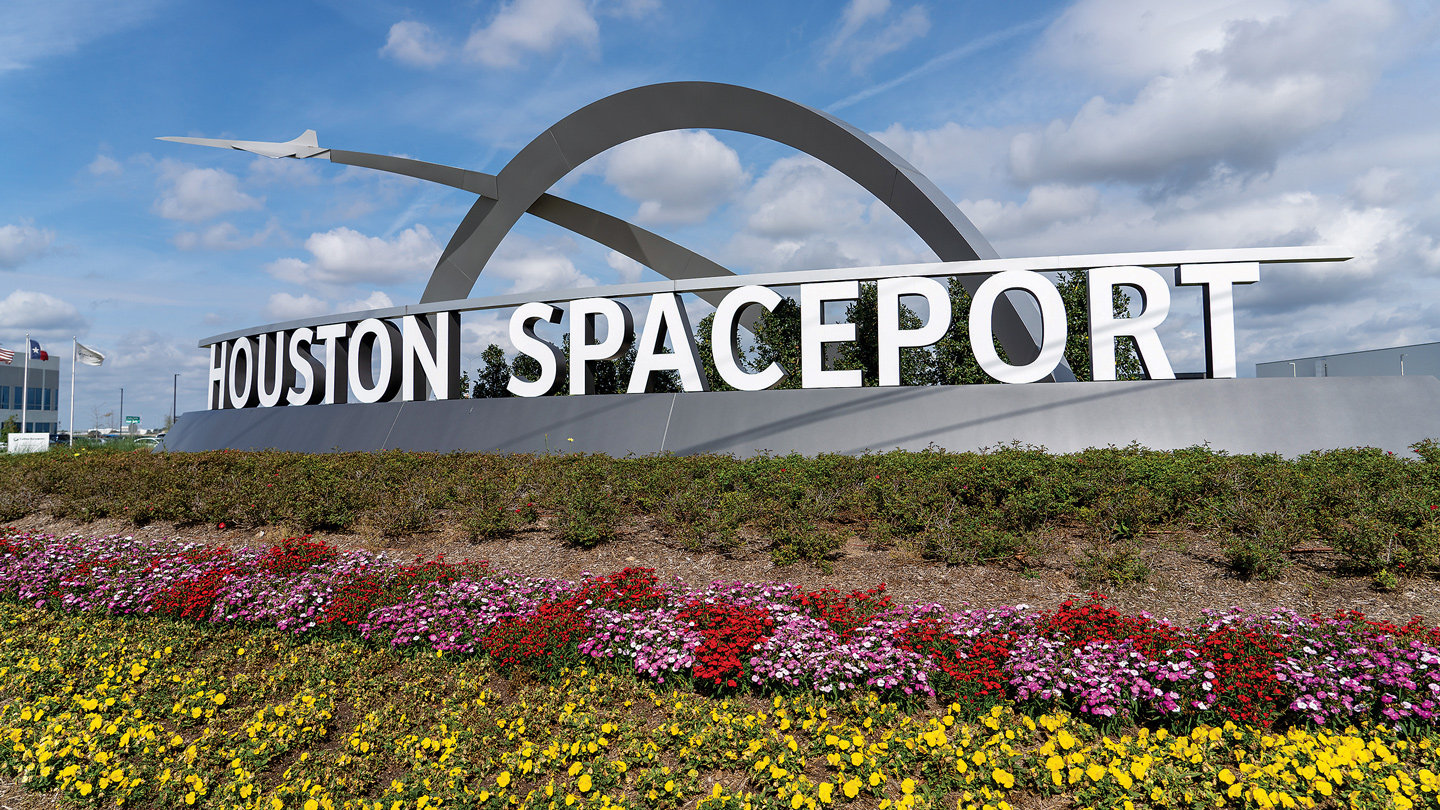primarily focused on infrastructure development, was completed in 2019. Courtesy of Houston Airports
The privatization of the space economy and the growing popularity of rocket tourism are launching new CRE opportunities around Houston and along Florida’s Space Coast.
The global space economy is poised to become a $1.8 trillion industry by 2035, growing 9% per annum from $630 billion in 2023. A joint report released earlier this year by the World Economic Forum and McKinsey & Company said this growth will “largely be built upon space-based and/or enabled technologies such as communications; positioning, navigation and timing; and Earth observation.”
SpaceX and Blue Origin are well-known names, but other industries are also benefiting from the space exploration boom, including commercial real estate. Two regions where economic activity has been ignited by the pivot away from government-driven space flight to multibillion-dollar contracts with private companies are Houston’s Bay Area and Florida’s Space Coast in Brevard County.
SPACE CITY
Houston is home to over 500 aviation and aerospace companies employing more than 23,000 individuals. NASA’s Johnson Space Center alone employs 10,000 people.
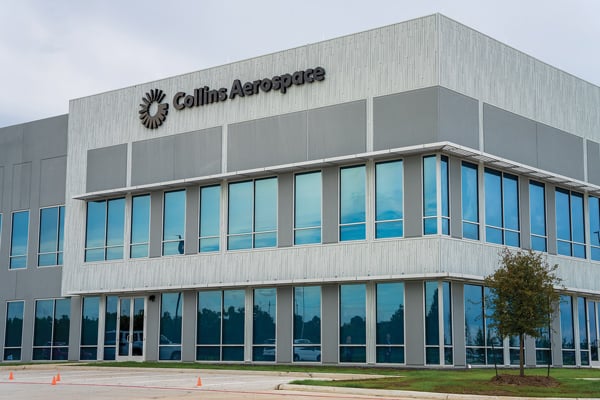
The Collins Aerospace campus at the Houston Spaceport includes a 120,000-square-foot facility and 8 acres for future expansion. Courtesy of Houston Airports
Houston’s abundance of scientific talent, combined with its status as the country’s fifth-largest metropolitan area and the gradual privatization of the space economy, led the Houston Airports System (HAS) in 2018 to embark on an ambitious multiphase development plan that would position the area to be at the forefront of space travel’s next chapter.
Houston Spaceport: Phase I
HAS seeks to develop 400 acres of greenfield at Ellington Airport, a city-owned airport primarily serving military and NASA operations. The Federal Aviation Administration (FAA) awarded HAS a spaceport license in 2015, making it the 10th spaceport in the United States. Phase I, encompassing approximately 153 acres, was completed in 2019 and largely focused on infrastructure development to support the creation of Houston Spaceport. The Houston City Council appropriated more than $18.8 million in public funds to assist with the construction of streets, water and wastewater, utilities, and communications infrastructure.
The spaceport also received a $5 million grant in 2022 from the Texas Economic Development & Tourism Spaceport Trust Fund program, which allocates funds toward the creation of jobs and infrastructure at Texas spaceports.
“When we started all this, the goal was to put the ‘space’ back in Space City [Houston’s nickname],” said Jim Szczesniak, director of aviation for HAS. “The purpose of that first phase was to try and attract those initial anchor tenants [to the spaceport].”
Collins Aerospace Building
Those efforts worked and the project now has three major tenants. Collins Aerospace, one of the world’s largest suppliers of aerospace and defense products, signed a 10-year lease in 2021, with three five-year renewal options, for a new 120,000-square-foot, 8-acre campus on spaceport grounds. In its press release announcing the deal, Collins said HAS would be providing up to $25.6 million in capital improvements financing. The facility also hosts Houston’s “first spaceflight incubator,” providing space and resources for startups and universities to collaborate and conduct research toward achieving new heights in space exploration.
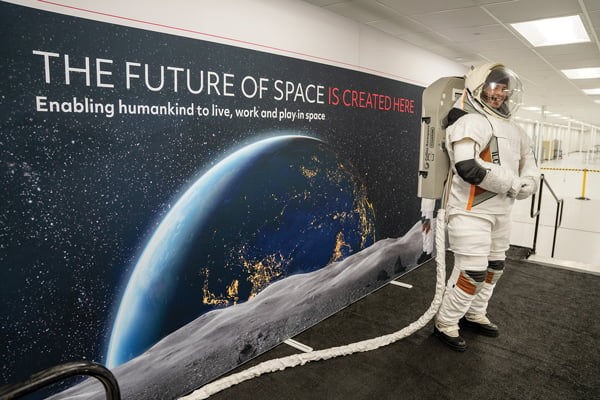
Celebrating the ribbon cutting of the Collins Aerospace facility in August 2022. Courtesy of Houston Airports
The participating higher education institutions include Rice University and its Rice Space Institute, and San Jacinto College, which leads the Edge Center, the spaceport’s official education training partner. Texas Southern University has also partnered with the spaceport to provide pilot training programs. And down the street at the Johnson Space Center, Texas A&M is scheduled to break ground in November on its new Space Institute facility — a massive project encompassing a 32-acre site owned by NASA.
HAS and Houston-based developer Griffin Partners, which is responsible for much of the commercial development in the surrounding Clear Lake and Nassau Bay submarkets over the past 40 years, broke ground on the Collins building in August 2021 and completed construction 12 months later. The Collins site includes additional acreage for future expansion.
Fred Griffin, chair and founder of Griffin Partners, said the total construction cost came to approximately $35 million, with the building makeup split roughly evenly between office space and lab and manufacturing space.
“The specifications of these facilities are very complicated,” Griffin said regarding the interior design of the lab and manufacturing space. “They are designing high-quality spacesuits here that will actually be worn by astronauts on the moon and Mars.”
Intuitive Machines Headquarters
Intuitive Machines, an American space exploration company, followed Collins’ lead and built a new 105,000-square-foot headquarters across the street. The company, which completed the first successful private moon landing this past February, worked with HAS, Griffin and engineering firm Burns & McDonnell to build its new Lunar Production and Operations Center. Construction of the 11-acre site cost approximately $45 million and was completed in September 2023.
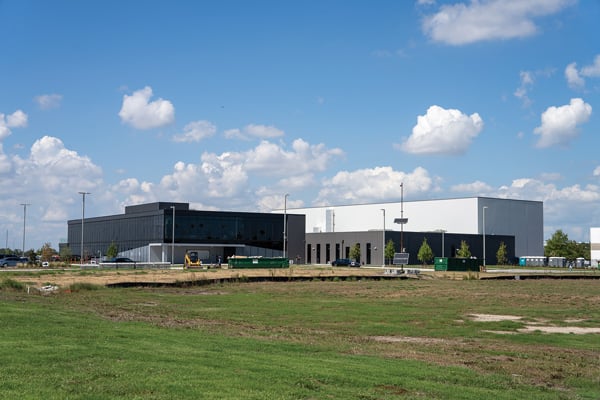
Intuitive Machines, an American space exploration company, opened its 105,000-square-foot headquarters at the Houston Spaceport in September 2023. Courtesy of Houston Airports
Intuitive Machine’s buildout included very specialized, high-tech interior designs, but that didn’t mean Griffin Partners received an extended deadline to complete the customized facilities. “When you’re working with the government [as Intuitive Machines is], there are certain dates you just have to meet,” Griffin said.
Axiom Space Headquarters
This was especially true with construction of the third major tenant’s facility, a new global headquarters for Axiom Space. Axiom is building a module that will, in essence, replace the International Space Station. Completion of that module is taking place in a new high-bay assembly space, built as part of the first phase of its two-phase corporate campus, a 106,000-square-foot manufacturing and testing facility.
Regulatory constraints made construction of the high-bay facility more challenging, especially with Axiom under contract to deliver the module for launch in 2026. Due to the facility’s proximity to the airport, it was necessary to use a flat crane, rather than the more standard tower crane, when constructing the facility to stay under the FAA’s 120-foot height restriction.
The first phase of Axiom’s 22-acre headquarters, referred to by the company as the Assembly Integration and Test Building, was completed in December 2023 after an 18-month construction process. Griffin said the project’s second phase will likely start by the end of 2024 and will include laboratory and office space, as well as mission training facilities for Axiom’s private astronauts.
Szczesniak said that between the three anchor tenants, plus additional university and HAS facilities, a total of 500,000 square feet of space has been built at the Houston Spaceport, representing $300 million worth of investment. From a broader economic perspective, $5 billion in contracted work has been generated, along with 1,800 jobs.
Future Plans
Building off the positive momentum of Phase I, HAS announced plans in April for Phase II, with an anticipated groundbreaking sometime in 2024 or 2025. Expansion of existing tenants’ operations will be part of this second phase, including the Edge Center’s plans for an Aerospace Institute, with the goal of connecting higher education students with the aerospace industry.
Smaller companies have also shown interest in relocating to the spaceport. Providing space for them is another goal of Phase II.
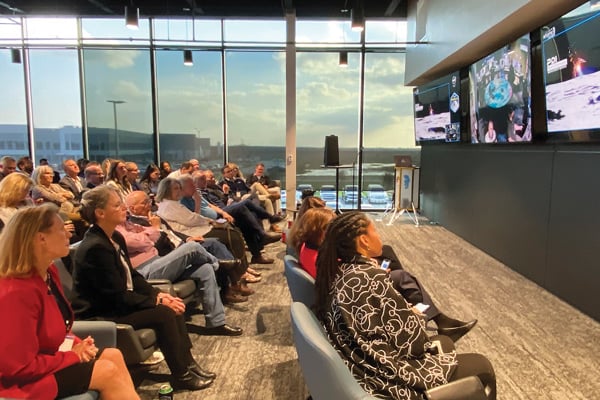
Intuitive Machines held a watch party at its headquarters in February for the lunar landing of Nova-C Odysseus, which the company designed. It was the first U.S.-made spacecraft to touch down on the moon in more than 50 years. Courtesy of Houston Airports
“We have these three main tenants on-site, and now their contractors are looking to hopefully co-locate with them. We are working on a multipurpose building that would allow these smaller companies to come in and take 10,000 to 30,000 square feet at a time,” Szczesniak said.
Constructing a road that runs through the middle of the spaceport and connects to state Highway 3 is also part of Phase II plans. The road will buffer land designated for potential hotel, retail and restaurant developments, introducing the opportunity for Houston Spaceport to tap into the growing tourism element of the new space economy.
Szczesniak believes the potential exists for Houston Spaceport to feature 1 million square feet of facilities by the time Phase II is complete. And plans for additional phases are still being discussed, suggesting the spaceport’s economic potential is still coming into view, particularly in the Bay Area submarket surrounding the spaceport.
According to a report from Colliers, the total office vacancy rate for Houston in the first quarter of 2024 was 26.7%. However, the Bay Area, referred to as the NASA/Clear Lake submarket in the Colliers report, had a vacancy rate of 15.7%.
When Collins announced plans for its new spaceport facility, that meant it would be vacating the space it leased at 18050 Saturn Lane, a Class A office building in Nassau Bay. But that didn’t frighten Lee & Associate’s Drew Lewis, who is the leasing agent on the property.
“Since the 1960s, engineering and scientific talent have called this area home. And when things change at the federal level, and projects are retired or contracts are lost, many of those individuals decide to stay here and take jobs with new companies or even start their own firms,” Lewis said. “Because of that workforce population, the area has attracted other industries that serve that clientele.”
Haldor Topsoe, a Danish company in the oil and gas sector, leased the fourth floor of 18050 Saturn Lane, formerly occupied by Collins. Lewis noted that the number of wealth management firms and health care providers in the area is growing to meet the needs of the space industry’s local workforce, adding dimensions to what is typically considered “the space economy” beyond its central scientific focus.
SPACE COAST
Brevard County, Florida, was the setting for numerous iconic Space Race images such as the Apollo 11 moon launch in July 1969. And it’s where NASA’s Space Shuttle program soared for the final time in 2011.
Brevard County features 72 miles of coastline along the Atlantic Ocean and is approximately an hour’s drive from Orlando, the amusement park capital of the world. According to a 2022 report from the Space Tourism Society, the top 10 U.S. space attractions welcome 18.3 million visitors annually. The Kennedy Space Center, located in Brevard County, and Mission: SPACE, a simulated NASA-style mission thrill ride at Disney’s EPCOT, accounted for over 40% of those visitors.
Rocket Tourism
In 2023, Cape Canaveral set a record for number of orbital launches in a single year: 72. That number could reach 115 by the end of 2024, according to Jay Cooper of Miami-based Driftwood Capital. Each of those launches is sponsored by different companies whose personnel fly in to witness the event, which means more people in need of more hotel rooms.
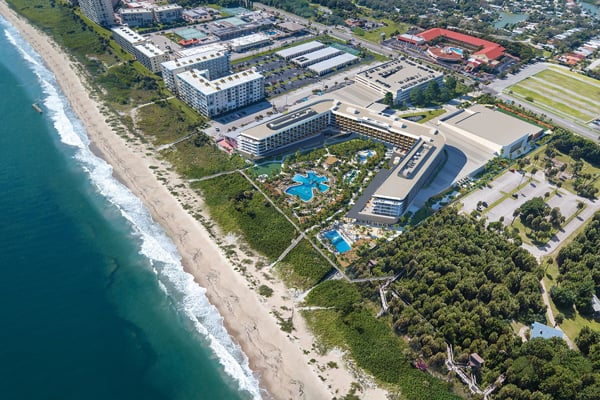
The Westin Cocoa Beach Resort & Spa will be positioned along 500 linear feet of coastline, providing a natural viewing platform for launch spectators. Courtesy of Driftwood Capital
This broader enthusiasm for space travel is why Driftwood, a real estate investor and developer specializing in hospitality, is moving full steam ahead on a project that Cooper, the company’s managing director of development and construction, calls the “crown jewel” of its portfolio.
The Westin Cocoa Beach Resort & Spa will be a 502-room hotel built on the 16-acre site formerly occupied by the International Palms Resort & Conference Center. Included in the project renderings is 123,000 square feet of flexible meeting space, which Cooper believes will be useful to NASA and military officials looking for sizable facilities to host launch-related conferences and meetings. Also planned for the resort are 11 food and beverage options, a full-service spa, multiple pools, and green space for a park. Marriott, Westin’s parent company, was drawn to Florida’s Space Coast because it felt the area lacked a full-service resort.
Cooper says the growth and demand along the Space Coast is unlike anything Driftwood has experienced. Much of that is attributed to “rocket tourism.” The Westin resort will have multiple attractions for launch enthusiasts, including a deep-water surf pool and bar that abuts the beach and has a direct line of sight to the Cape Canaveral launchpad. The resort is also positioned along 500 linear feet of coastline that provides a natural viewing platform for launch spectators. That stretch of beach raises the project stakes.
“You have some of the most amazing beaches along that stretch of the coast, and some of the best surf as well,” Cooper said. “There’s only so much natural coastline like this left, so you really need to get it right the first time so as to not jeopardize what makes this area so wonderful.”
The developer bought the site for $23 million in 2016 and is reported to be spending between $300 million and $400 million to replace what Driftwood CEO Carlos Rodriguez Sr. termed “the ugly duck” of the Space Coast due to International Palms’ dilapidated condition and penchant for inviting crime.
Driftwood is currently raising funds for the project from investors, partnering primarily with high-net-worth individuals, as it has on previous projects. An August 2024 groundbreaking was anticipated for the project. Once complete, room reservations will start at $300 per night. Luxury residences will include 69 suite offerings and two 2,000-square-foot presidential suites — options Cooper is confident will come in handy as the scale and importance of the Cape Canaveral launches continue to grow.
Commercial Space for Space Employers
Hospitality isn’t the only real estate sector in Brevard County benefiting from enthusiasm over the launches. Office and industrial space occupancy rates in the area are dramatically outpacing the rest of the country. Brevard County industrial properties have a 2.2% vacancy rate, and office is at 6.4%, according to Rob Beckner, principal of the Lightle Beckner Robison brokerage firm.
“Having Elon Musk [founder of SpaceX] and Jeff Bezos [founder of Blue Origin] in the area has created a bit of a ripple effect in the local economy,” Beckner said. “New engineering firms and parts manufacturers have come to town, and it’s changed the landscape entirely.”
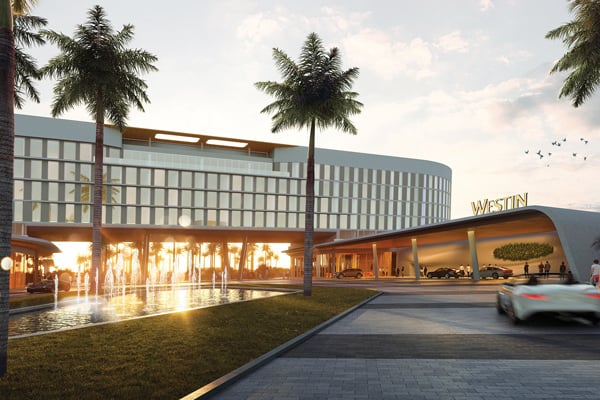
A rendering of the Westin Cocoa Beach Resort & Spa, being developed along Florida’s Space Coast to take advantage of the growing enthusiasm for rocket tourism. Courtesy of Driftwood Capital
Anytime someone calls Beckner looking for space in Titusville, the closest commercial submarket to NASA’s Cape Canaveral operations, he tells them to meet him an hour south in Melbourne, because there simply isn’t square footage available. Beckner’s firm was the listing agent on the Reich Brothers Logistics Center in Titusville, marketed on its brochure as “the only Class A Industrial/Flex Building” in the area. According to online sources, Beyond Gravity, a rocket and satellite parts supplier, leased nearly all of the 137,000 square feet of space in short order.
The race for space in the commercial market has had a significant impact on rates. Beckner said industrial space is leasing for $12–$13 per square foot net, while office is approaching $20 per square foot.
Beckner shared similar sentiments to Griffin’s when discussing the intricacies of not only these tenants’ space requirements but the complexities of the lease documents themselves.
“Terms like ‘setup’ are used instead of ‘tenant improvements,’ which seems meaningless, but it has significant meaning in this context,” Beckner said. “The federal contracts these companies sign dictate how capital improvement dollars are spent, so you really have to know what you’re doing and understand how these contracts work.”
Beckner said that in the past, the area’s economy followed a boom-and-bust cycle, depending on federal funding for various NASA projects. He believes things are different this time around and that the jobs are here to stay.
“As space exploration continues to expand, so will the services offered. It’s a much more robust economy now,” Beckner said. “There’s a sense of permanency with it, and I believe Florida, and in particular this area, will be the driver for this growth for years to come.”
Will McDonald is a freelance writer in Brooklyn with prior professional experience as a commercial real estate broker.
Select Space-related Developments Across the CountryCalifornia: The Berkeley Space Center is a proposed 36-acre research and development hub located within NASA’s Ames Research Center in Silicon Valley. The $2 billion project is a joint venture between the University of California, Berkeley and San Francisco-based real estate developer SKS Partners, with the stated aim of “catalyzing deeper collaboration between the private, academic and governmental sectors.” Metro D.C./Maryland: Intuitive Machines signed a 21,117-square-foot lease at the Cromwell Business Park outside of Washington, D.C., in June. The facility, an expansion from Intuitive’s existing 3,600-square-foot operations in Maryland, will be used primarily for building and testing new space-flight equipment. Ohio: British aerospace company Blue Abyss acquired 12 acres in Brook Park earlier this year to build what is expected to be the largest commercial astronaut training center in the world. Plans include a 130-room boutique hotel to host students and visitors traveling to the campus. The facility will be near NASA’s Glenn Research Center. |
